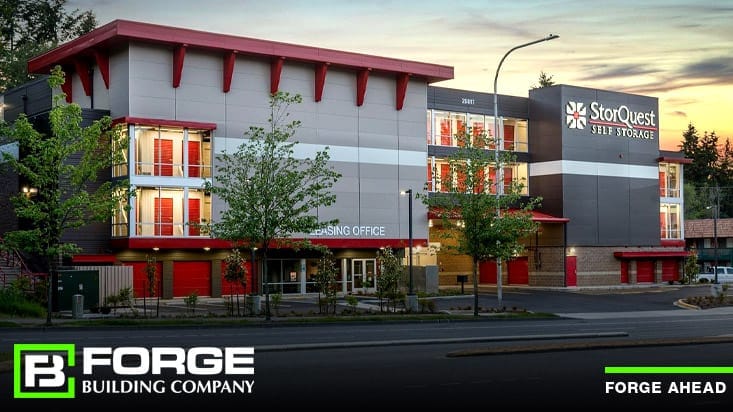
Storage facilities are found virtually everywhere in the U.S. In fact, self-storage units are among the highest-yielding real estate investments on the market. Once maintenance and security are in place, owners are free to collect numerous rent checks per square foot. Moreover, storage facilities remain buoyant during poor economic conditions.
The United States is the main player in the self-storage industry, where the industry is estimated to be worth $38 billion. There are approximately 50,000 storage unit facilities throughout the U.S offering more than 2.3 billion square feet of self-storage space.
About 18% of the industry is owned by the top five players, U-Haul and four (4) REITs (real estate investment trusts). This fact illustrates that there are numerous small, independent self-storage operations throughout the country building storage units. At any given time, about 10% of American households rent commercial storage units.
Life events such as moving, divorce and even death often trigger the need for temporary and long-term storage. It’s no wonder that more and more investors are looking for contractors to build commercial storage buildings.
Competition among self-storage units is greatest in metropolitan areas, where available, properly zoned land is at a premium. Many units are manufactured modular buildings that are easy and relatively quick to assemble. For this reason, building storage units has never been easier or more cost-effective.
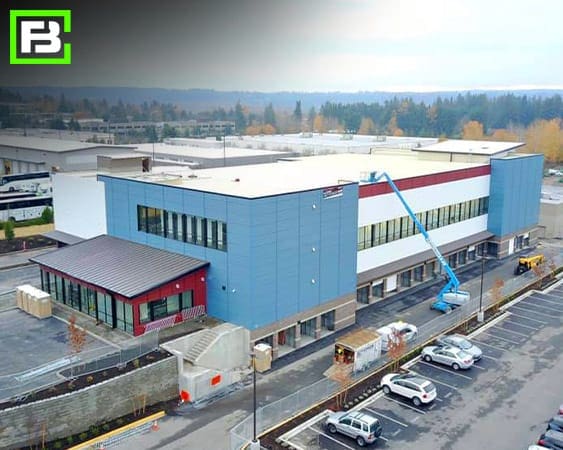 Vacant land can become an income producing asset for landowners looking to increase revenue. Land is valuable, and while land may be most valuable when a structure is built on it, this doesn't mean it can start producing income immediately. It all takes proper planning with the right steel building contractor that fully understands the entire process from land acquisition to the architectural process to final construction.
Vacant land can become an income producing asset for landowners looking to increase revenue. Land is valuable, and while land may be most valuable when a structure is built on it, this doesn't mean it can start producing income immediately. It all takes proper planning with the right steel building contractor that fully understands the entire process from land acquisition to the architectural process to final construction.
If you’re in the position of buying land for the purpose of converting it into a commercial storage development, you’ll need to understand a few things.
The minimum size of a self-storage facility is usually 40,000 square feet of rentable space, which typically requires two to three acres of land. The best sites are situated at major intersections that are easy to access and near a high, population density in a growing region.
Ideally, a self-storage facility would be free of nearby competitors and would also be close to a retail center. Of course, local zoning must permit building storage units in that specific location. So it is key to understand:
Every lot is different. You will likely have the option of using the equity in the land to pay the down payment on a construction loan. A lot goes into the development process, and lenders want to ensure they have as little risk as possible when lending money.
Putting the land up as equity when owned allows you to avoid paying cash for the down payment. Some lenders may require a cash investment, but this varies from lender to lender.
Once your loan is approved, you can begin developing the land into an income-producing storage facility. Storage units can generate a lot of revenue when you have the right structure built for that particular area.
In a previous blog titled “Building a Commercial Storage Building” we covered how to successfully build and develop a self-storage facility.
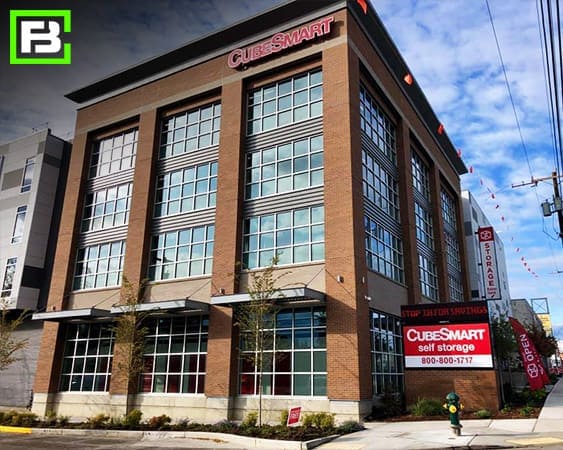 Self-storage buildings offer a variety of individual storage rooms. In square feet, the most popular storage room sizes include: 5×10, 10×10, 10×20, 10×30, 15×20 and 20×20 (the later of which is approximately the same size as a two-car garage).
Self-storage buildings offer a variety of individual storage rooms. In square feet, the most popular storage room sizes include: 5×10, 10×10, 10×20, 10×30, 15×20 and 20×20 (the later of which is approximately the same size as a two-car garage).
The units typically have corrugated-metal walls, no windows and can be locked by the renter/tenant. Access to the facility may be secured by clerical staff, security guards, digital gate codes, alarms and security cameras.
Individual units might have a conventional lock or perhaps something more high-tech, such as a keypad, card reader, or biometric scanner. Higher-end units provide climate control, around the clock access, and power outlets within individual units.
For a sample of the types of single-story self-storage buildings that Forge offers, please check out: Single-Story Self-Storage Building Contractors.
Here are three points you should consider before hiring a storage building contractor:
The cost to build storage units starts with land costs and parcel sizes. A facility of 40,000 square feet requires a land parcel size of 2 to 3 acres. You need 3 to 4 acres for 60,000 square feet and 4 to 5 acres for 80,000 square feet, and so on.
Generally, about 40% of a storage facility’s customer base demands climate-controlled units. This feature increases rental prices 25% to 60%, but costs only 10 cents per square foot! In other words, climate control has an incredibly high return on investment (ROI).
The coverage ratio of a site is the amount of land covered by the storage facility. For example, if you have 6,000 square feet of coverage on an 8,000 square foot lot, your coverage ratio is 75%. Naturally, the higher the ratio, the more revenue you can squeeze out of the storage facility. So bear that in mind before you start building storage units.
For single-story units, expect to pay $25-$40 per square foot, but multistory self-storage units typically cost $42-$70 per square foot. Additional cost factors like electricity, plumbing, and security systems can add $15-$45 per square foot. (source: Assets America)
In terms of constructing storage unit buildings, the cost can be relatively affordable. Depending on the region and building size, expect to pay $25,000-$100,000 for simple, steel buildings with 10-50 units. The cost to build storage units can be surprisingly within reach.
Developing land is a costly venture but finding the funds to develop the land with the best steel building contractor will also reap the highest return on investment.
Costs have changed since the posting of this blog. The hard and soft costs of construction will vary from project to project. Let’s break it down.
Keep in mind, that prices in materials, such as steel, may fluctuate and this directly impacts the cost per square foot. Also, you may be building in an area that is experiencing labor shortages causing the labor prices to increase as well.
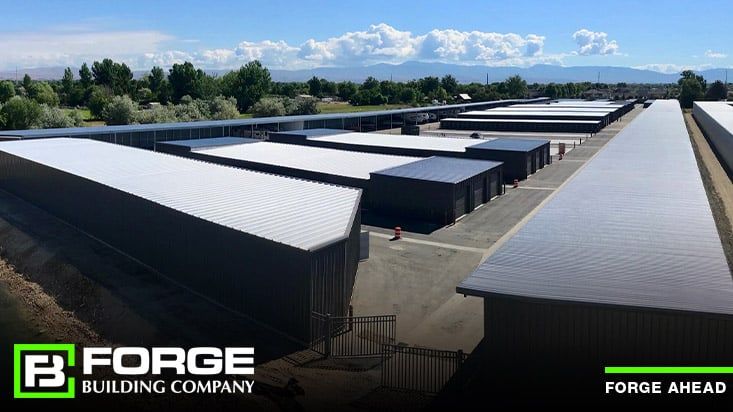
Through both good and bad economic times, the self-storage sector has proven to be a steady performer. That’s why so many investors want to get a piece of the action. To do so, you can either buy an existing self-storage facility or develop a new one. Successfully building a commercial storage building involves several factors, including choosing the right site, design, the correct unit mix, and layout. This may sound simple, right? Not so fast. Read more about these fundamentals and get advice on how to achieve optimal results.
If you go down the development path, one key question is: How much money will you need? There’s no simple answer to that question, as the cost can vary based on several factors, such as location and the number of self-storage units.
Ultimately, the goal of any self-storage development should be financial success, and the best way to accomplish that is to carefully plan the basics: site selection, unit mix, and layout. For many, the industry business model looks simple: buy land, build, and make money. It may once have been that simple, but today, it’s much more complex.
The commercial storage building market, like many similar markets are experiencing greater competition, higher land and building costs, and additional regulatory burdens. The industry, in general, is seeing the use of more climate-controlled and multi-story buildings, due in part to trends in consumer demand. As a result, self-storage facilities are becoming much more expensive to develop, with longer lease-to-stabilization times. Even so, they continue to be a solid investment choice.
Choosing the right site and creating a well-designed unit mix and layout is critical, especially for a first-time developer. These are the fundamentals of building a successful storage business, whether you’re building your first or fortieth facility.
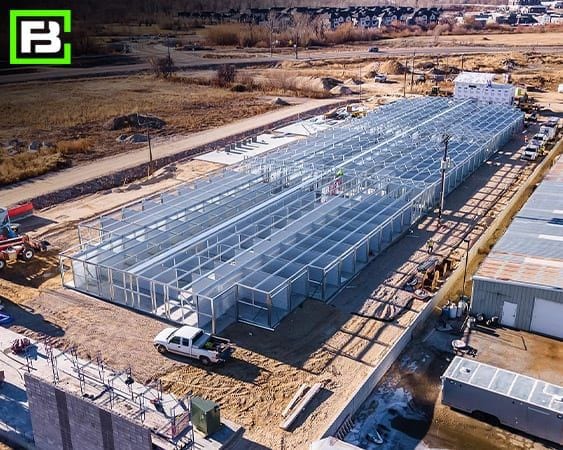
Site selection is the most critical factor in planning for the success of a commercial storage building. It is important to select a highly visible location, has good access, and is located on a major road. The site should be in a high-growth area or one that’s clearly in the path of progress for that region. In addition, it’s key to look for a good combination of demographics, with higher-than-average household income and population growth within a three-mile trade area. Finally, the location should have minimal existing or planned self-storage competition, particularly within the first few miles.
When you discover an area that’s underserved, chances are other self-storage building manufacturers and developers have noticed it as well. Check with the local building authority to see what’s being planned before starting a building project. You don’t have to let competitive forces sway your decision but it’s good to be aware of all existing and planned projects.
Once the site selection is determined, it is key that the property is large enough for your planned development and that it has access to the proper utilities, such as water, sewer, and electricity. It should also be properly zoned.
It is critical to understand that not all land is good for self-storage. A good site must have the attributes discussed previously. If it doesn’t, it is best to keep looking for one that does.
Typically, a single-story self-storage development might require three to five acres, depending on topography and shape. Whereas a multi-story self-storage site may only require two acres or so. The ideal site should give you a high level of confidence about all of the specifics of that particular location.
Generally, you can count on a self-storage facility costing $25 to $70 per square foot to build. That range can vary greatly. For instance, the cost of steel may go up or down at any given time, or the area where you’re building the facility may be experiencing a labor shortage. And, of course, you’ll certainly face higher costs in a major metro area than you would in a small community.
Self-storage unit mix is normally a product of population density and income levels. So it is key that you understand the market in which you are building the commercial storage-units. For example, areas of higher income will typically demand more security and climate-controlled features; apartment dwellers will want smaller units, say 5-by-10s; and suburban or commercial-oriented markets will call for larger spaces, such as 10-by-20s. Also, see our article on Determining the Right Unit Mix.
It’s important to note that your financial return per square foot (PSF) usually diminishes as the size of the unit increases. For example, if your market will support $70 for a 5-by-10, you’re achieving a rental rate of $16.80 PSF. It’s doubtful the 10-by-20 will support that same rate. This doesn’t mean you should build a higher proportion of smaller units, though. A store with 50,000 net rentable square feet might have more than 500 storage units or as few as 300, depending on the market. You must build the unit mix to the market, not to skew the PSF return.
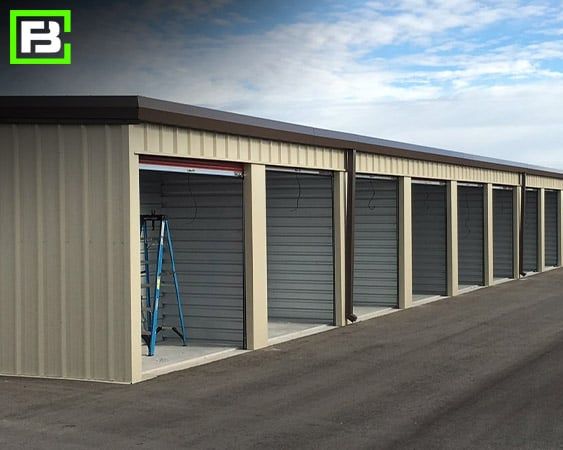
When you’re looking to develop a self-storage facility, you obviously must decide where to build it. Be prepared, finding a great site for storage can be tricky. You’ll need to find a site for the right price, with the right zoning, and the right demographics to support your business.
To discuss site layout, it’s key to understand building a single-story versus a multi-story storage facility. The layout process typically begins with the involvement of a professional civil engineer with experience in self-storage design, which can be invaluable. The goal is to maximize the net rentable square footage. You’ll typically be hunting for 2.5 to 5 acres to accommodate the facility. Land costs typically make up about 25% to 30% of the entire development budget and you will also need a site that will accommodate a minimum of 50,000 square feet, constructed all at once or in phases.
A single-story facility usually costs $25 to $40 per square foot. Construction of a multi-story facility typically costs more — $42 to $70 per square foot. These figures don’t include land or site improvement costs.
Of course, this isn’t a consideration if you already own property suited for a storage facility, although you still may need to go through the costly, time-consuming process of rezoning the land.
The layout is primarily a product of the shape and topography of the land parcel, but many other factors come into play, including:
At Forge, we normally factor in all the setbacks, easements, and storm-water restrictions first. From there, our drafters will then sketch the layout. Next, we try to determine how much climate-controlled versus non-climate-controlled storage can fit on the site. Then we look at accessibility to each of the buildings and individual units, ensuring it will be easy for customers to access their storage space. If it isn’t reasonably simple for tenants to drive in, get to their unit, and store their items, they’ll go elsewhere.
The key takeaway here is that it is critical to find the right site, then design the unit mix and layout based on that particular market. Doing the research and spending time with professional engineers and planners will help you succeed in your self-storage development. Remember, it’s a process that will involve a considerable amount of time and money, but the end reward will be worth it. At Forge, we can simplify the process by giving you a one-stop shop for all of your commercial storage building needs. Then once your new storage business is off to a solid start, you’ll be ready to focus on your next self-storage development project!
Related article: Before Construction Begins: Fundamentals of Building Self-Storage
Costs have changed since this blog was posted. The hard and soft costs of construction will vary from project to project. Let’s break it down.
Keep in mind, that prices in materials, such as steel, may fluctuate and this directly impacts the cost per square foot. Also, you may be building in an area that is experiencing labor shortages causing the labor prices to increase as well.
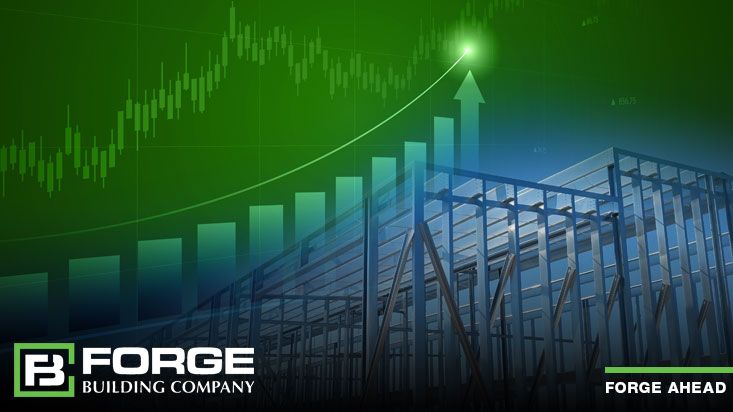
As the year winds down and you look at the overall commercial real estate market, there were definitely challenges – retailers were closing doors, the future of office space is still uncertain, supply chain issues have persisted, and inflation is near 40-year highs prompting the Fed to steadily increase interest rates1. However, there are still bright spots in the commercial real estate market forecast. The one asset class that has outperformed all the others in 2021 was self storage. With an average occupancy of 92%, self storage is a viable option for those looking for alternative investment opportunities as it provides income and inflation resistance (since rates can change daily2.
Also see our blog, "Why Self Storage in a Recession?"
In today’s self storage industry, almost 40% of Americans rent a self storage unit with Gen X leading the other age groups. This segment of the commercial real estate industry is growing tremendously in popularity because it assists people during many key life events – growing your family, downsizing, moving, death, and divorce. Typically, homeowners with smaller homes tend to use self storage more, but the percentage of owners of larger homes is also on the rise3.
The primary reason investors are now looking at this asset class is because it can be an inflation hedge. Most units are on a month-to-month rent, which can increase each month to keep up with inflation. According to the 2023 Self-Storage Almanac, consumers typically rent a 10x10 storage unit. The rent for these units increased by 13% in 2022. In 2001-2023 the average return on self-storage was 20.87%, and in 2006-2021 it was 18.76%. Numbers like this are gaining the attention of investors.
Furthermore, the average sale price of storage properties has appreciated by more than 30% over the past five years4.
See "2022 Outlook for Self Storage."
Also, see what the Forge President and CEO have to say about "Self storage as an investment."
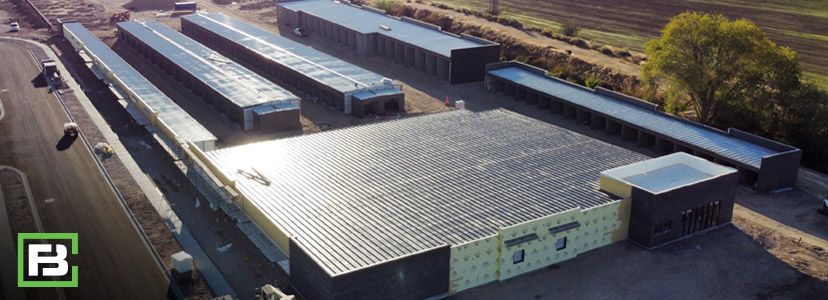
In today’s market, you do not necessarily need to buy and build your own self storage facility. Some companies create self storage turnaround investments that are for accredited investors. These funds tend to buy self-storage units from “mom and pop” operators and add economies of scale, invest in the properties, and increase the return on investment (ROI) for investors.
So, whether an investor wants to buy and own a self storage facility outright or just benefit from the long-term economic benefits, self storage facilities stand to serve both types of investors well5.
1. Brooks, A. (2022, December 2). J.P. Morgan. Retrieved from jpmorgan.com: https://www.jpmorgan.com/insights/outlook/economic-outlook/2023-commercial-real-estate-trends
2. Hubler, F. (2023, September 5). Forbes. Retrieved from Forbes.com: https://www.forbes.com/sites/fredhubler/2023/09/05/self-storage-isnt-just-for-hoarders-a-primer-for-investors/?sh=2e5e810d77be
3. Mohan, M. (2022, August 15). Storage Cafe. Retrieved from storagecafe.com: https://www.storagecafe.com/blog/self-storage-use-and-main-demand-drivers/
4. Weinstock, S. D. (2022, January 15). Inside Self Storage. Retrieved from insideselfstorage.com: https://www.insideselfstorage.com/market-conditions/how-will-self-storage-perform-year-ahead-real-estate-market-outlook-2022
5. Cone, J. (2018, January 11). U.S. News and World Report. Retrieved from money.usnews.com: https://money.usnews.com/money/blogs/the-smarter-mutual-fund-investor/articles/2018-01-11/self-storage-is-an-investment-alternative